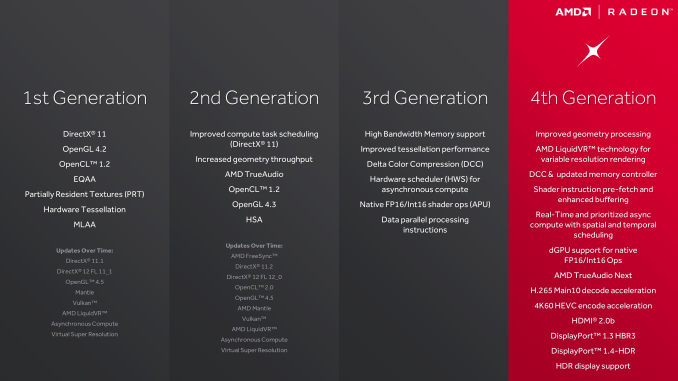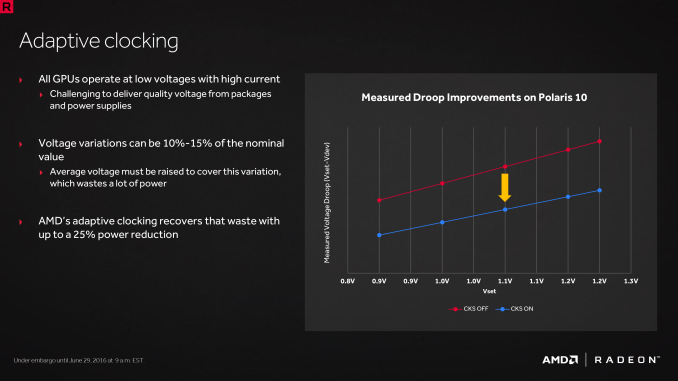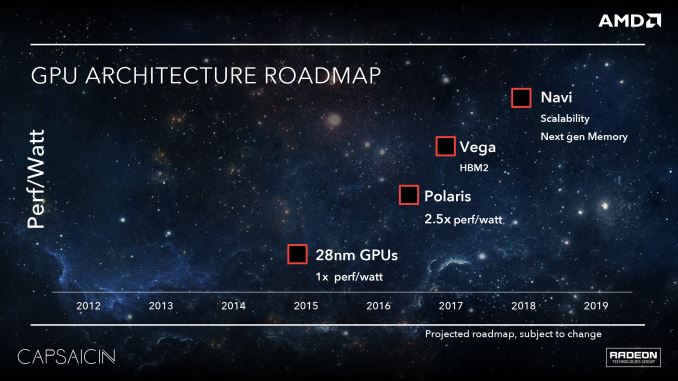The AMD Radeon RX 480 Preview: Polaris Makes Its Mainstream Mark
by Ryan Smith on June 29, 2016 9:00 AM ESTAMD's Path to Polaris
With the benefit of hindsight, I think in reflection that the 28nm generation started out better for AMD than it ended. The first Graphics Core Next card, Radeon HD 7970, had the advantage of launching more than a quarter before NVIDIA’s competing Kepler cards. And while AMD trailed in power efficiency from the start, at least for a time there they could compete for the top spot in the market with products such as the Radeon HD 7970 GHz Edition, before NVIDIA rolled out their largest Kepler GPUs.
However I think where things really went off of the rails for AMD was mid-cycle, in 2014, when NVIDIA unveiled the Maxwell architecture. Kepler was good, but Maxwell was great; NVIDIA further improved their architectural and energy efficiency (at times immensely so), and this put AMD on the back foot for the rest of the generation. AMD had performant parts from the bottom R7 360 right up to the top Fury X, but they were never in a position to catch Maxwell’s efficiency, a quality that proved to resonate with both reviewers and gamers.
The lessons of the 28nm generation were not lost on AMD. Graphics Core Next was a solid architecture and opened the door to AMD in a number of ways, but the Radeon brand does not exist in a vacuum, and it needs to compete with the more successful NVIDIA. At the same time AMD is nothing if not scrappy, and they can surprise us when we least expect it. But sometimes the only way to learn is the hard way, and for AMD I think the latter half of the 28nm generation was for the Radeon Technologies Group learning the hard way.
So what lessons did AMD learn for Polaris? First and foremost, power efficiency matters. It matters quite a lot in fact. Every vendor – be it AMD, Intel, or NVIDIA – will play up their strongest attributes. But power efficiency caught on with consumers, more so than any other “feature” in the 28nm generation. Though its importance in the desktop market is forum argument fodder to this day, power efficiency and overall performance are two sides of the same coin. There are practical limits for how much power can be dissipated in different card form factors, so the greater the efficiency, the greater the performance at a specific form factor. This aspect is even more important in the notebook space, where GPUs are at the mercy of limited cooling and there is a hard ceiling on heat dissipation.
As a result a significant amount of the work that has gone into Polaris has been into improving power efficiency. To be blunt, AMD has to be able to better compete with NVIDIA here, but AMD’s position is more nuanced than simply beating NVIDIA. AMD largely missed the boat on notebooks in the last generation, and they don’t want to repeat their mistakes. At the same time, starting now with an energy efficient architecture means that when they scale up and scale out with bigger and faster chips, they have a solid base to work from, and ultimately, more chances to achieve better performance.
The other lesson AMD learned for Polaris is that market share matters. This is not an end-user problem – AMD’s market share doesn’t change the performance or value of their cards – but we can’t talk about what led to Polaris without addressing it. AMD’s share of the consumer GPU market is about as low as it ever has been; this translates not only into weaker sales, but it undermines AMD’s position as a whole. Consumers are more likely to buy what’s safe, and OEMs aren’t much different, never mind the psychological aspects of the bandwagon effect.
Consequently, with Polaris AMD made the decision to start with the mainstream market and then work up from there, a significant departure from the traditional top-down GPU rollouts. This means developing chips like Polaris 10 and 11 first, targeting mainstream desktops and laptops, and letting the larger enthusiast class GPUs follow. The potential payoff for AMD here is that this is the opposite of what NVIDIA has done, and that means AMD gets to go after the high volume mainstream market first while NVIDIA builds down. Should everything go according to plan, then this gives AMD the opportunity to grow out their market share, and ultimately shore up their business.
As we dive into Polaris, its abilities, and its performance, it’s these two lessons we’ll see crop up time and time again, as these were some of the guiding lessons in Polaris’s design. AMD has taken the lessons of the 28nm generation to heart and have crafted a plan to move forward with the FinFET generation, charting a different, and hopefully more successful path.
Though with this talk of energy efficiency and mainstream GPUs, let’s be clear here: this isn’t AMD’s small die strategy reborn. AMD has already announced their Vega architecture, which will follow up on the work done by Polaris. Though not explicitly stated by AMD, it has been strongly hinted at that these are the higher performance chips that in past generations we’d see AMD launch with first, offering performance features such as HBM2. AMD will have to live with the fact that for the near future they have no shot at the performance crown – and the halo effect that comes with it – but with any luck, it will put AMD in a better position to strike at the high-end market once Vega’s time does come.













449 Comments
View All Comments
Drumsticks - Wednesday, June 29, 2016 - link
I have heard this is true, but what does Anandtech (and many others) measure by? Most reviews show the 480 and the 970 very close in power draw.Polaris definitely appears to be a little bit more efficient than Maxwell, but likely less a good bit less efficient than Pascal. It's definitely better than the 3XX vs Maxwell days though.
looncraz - Wednesday, June 29, 2016 - link
Compared to the 970, the RX 480 has better power consumption for the performance, yes. Not by much, but that value should increase with AIB versions as the reference runs rather warm and has a less than efficient VRM.Only time will tell how that consumption changes with clock speeds and how much overclocking can be genuinely achieved from the chip, but at this point, stock vs stock, the RX480 is a better buy than the 970.
The 1060 is another matter altogether. It will certainly use less power and clock better than the RX 480, so we can assume that it will perform better as well - with nVidia simply tweaking its default clocks to best the RX 480. Still, it looks like the 1060 will have only 3GB or 6GB of RAM, so the cheaper RX 480 will fair better in RAM-heavy scenarios than the cheaper 1060.
just4U - Wednesday, June 29, 2016 - link
There is no guarantees on the 1060.. especially if it's 128bit. The 960 was a little on the disappointing side. Especially considering what you had to pay for it. (I know.. I own a 960 4G and a 380..)fanofanand - Thursday, June 30, 2016 - link
I wouldn't know how disappointing the 960 was, seeing as Anandtech never thought it worthy of review. *zing*gnawrot - Wednesday, June 29, 2016 - link
I am pretty sure that AMD can deliver Vega in 2017 if they want to. In the mean time they will release their server CPUs (more profitable market). They cannot launch that many products at the same time.Michael Bay - Wednesday, June 29, 2016 - link
Their server CPUs which nobody even wants. This particular battle was lost a decade ago.Domaldel - Thursday, June 30, 2016 - link
Not really if what we've heard about Zen is correct.32 cores and 64 threads with each core roughly matching Broadwell clock for clock at a lower price point?
While all of that could of course be bull there's also potential here for some serious disruption in the CPU market.
And Zen is probably higher priority for AMD then the GPU market as a whole.
Gigaplex - Thursday, June 30, 2016 - link
I doubt they'll match Broadwell clock for clock. They'll probably fall in the Nehalem to Sandy Bridge range. That should be enough though to cause some disruption in the CPU market if the price is right.mikato - Friday, July 29, 2016 - link
So are you saying, Michael Bay, that if they released a CPU that was competitive or better price-performance-efficiency and Intel's then it wouldn't be successful? It sounds like that is what you are saying.r@ven - Wednesday, June 29, 2016 - link
What are you stupid? The R9 390 was already made in the time to compete the 970. And even faster in 1440P.